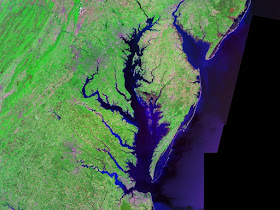 |
| Representation of Thomas Hooker's Settlement of Connecticut |
The main access to the interior of the American continent was by following the rivers upstream. It is no coincidence that most of the major cities in the United States are built along rivers. The most obvious access point is the vast Chesapeake Bay. Technically, the Bay is really an estuary. An estuary is a flooded river valley where the tides from the ocean meet a river stream. Here is a satellite view of the Chesapeake that shows its size.
 |
Satellite (Landsat) picture of Chesapeake Bay (center) and Delaware Bay (upper right) - and Atlantic coast of the central-eastern United States. |
 | |
| New York STS058-081-038 |
Accordingly, the migration patterns of American immigrants were governed by geographic reality: mountains and rivers. To begin to understand how your ancestors moved, you need to look to both the mountains and the rivers.
One of the basic motivations for movement from the Atlantic seaboard was the constant increase in population. One major motivating factor in moving to America was to obtain land ownership. Even though many immigrants came as enslaved people or indentured servants, those who came voluntarily were interested in land. Even among the well-known Mayflower passengers, some of the immigrants were not motivated by a desire to have religious freedom but were merchants and craftsmen. There were also some orphaned children and indentured servants. See Mayflower Compact.
It was over a hundred years after the first settlements along the Atlantic Coast before the interior began to be settled. As genealogists, before assuming that our early American ancestors were born in places like Kentucky or Tennesee, we need to be aware of the availability of transportation into these inland areas. One example is the Susquehanna River; the longest river on the East Coast. Here is a map of the Susquehanna River Basin.
 |
| By I, Karl Musser, created it - Own work: based on USGS data., CC BY-SA 2.5, https://commons.wikimedia.org/w/index.php?curid=735204 |
- Vermont 1724
- Ohio 1788
- Kentucky 1774
- Tennessee 1768
- Arkansas 1686
The largest interior town in America, for many years, was Lancaster, Pennsylvania. The main road from Philadelphia to Lancaster was the Lancaster Turnpike. Here is a description from Wikipedia: Philadelphia and Lancaster Turnpike.
The Philadelphia and Lancaster Turnpike, first used in 1795, is the first long-distance paved road built in the United States, according to engineered plans and specifications. It links Lancaster, Pennsylvania, and Philadelphia at 34th Street, stretching for sixty-two miles. However, the western terminus was actually at the Susquehanna River in Columbia. The route is designated PA 462 from the western terminus to US 30, where that route takes over for the majority of the route. The US 30 designation ends at Girard Avenue in the Parkside neighborhood of Philadelphia, where State Route 3012 takes it from there to Belmont Avenue. At Belmont Avenue, State Route 3005 gets the designation from Belmont Avenue until the terminus at 34th Street.Note that the road ran to the Susquehanna River. Genealogical research becomes more manageable as you begin to realize that your ancestors lived in the context of their own history and that movement in the earliest times was dramatically restricted from what it is today.
You can see the earlier posts in this series here:
http://genealogysstar.blogspot.com/2018/02/from-whence-and-to-thither_14.html
http://genealogysstar.blogspot.com/2018/02/from-whence-and-to-thither_11.html
http://genealogysstar.blogspot.com/2018/02/from-whence-and-to-thither.html
https://genealogysstar.blogspot.com/2018/01/from-whence-and-to-thither_10.html
https://genealogysstar.blogspot.com/2018/01/from-whence-and-to-thither.html
http://genealogysstar.blogspot.com/2017/12/from-whence-and-to-thither_31.html
http://genealogysstar.blogspot.com/2017/12/from-whence-and-to-thither.html

No comments:
Post a Comment